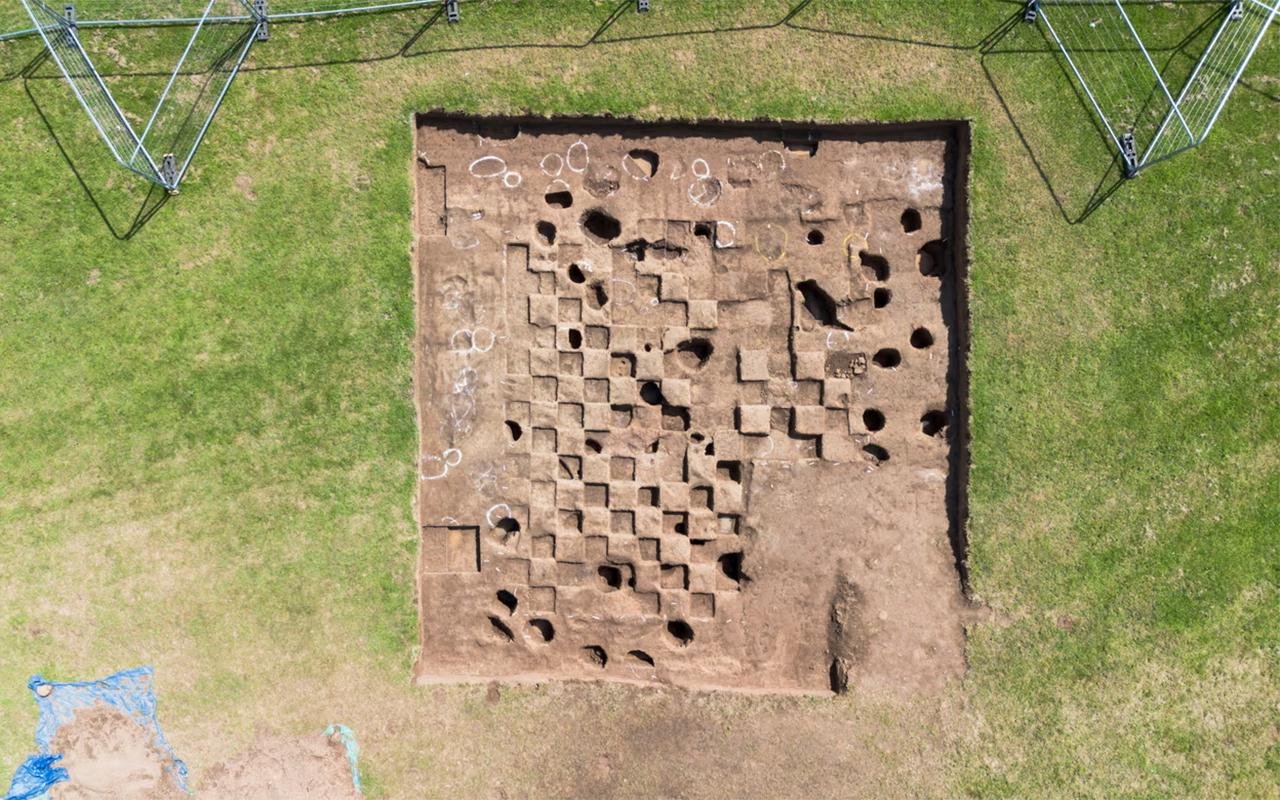The Caerau and Ely Rediscovering (CAER) Heritage Project has resumed its archaeological investigations in Trelai Park, Cardiff, uncovering a trove of artifacts.
 An aerial view of the remains of bronze age houses and a timber stone circle found at the Trelai Park site in Cardiff. Credit: Vivian Thomas/ Cardiff University
An aerial view of the remains of bronze age houses and a timber stone circle found at the Trelai Park site in Cardiff. Credit: Vivian Thomas/ Cardiff University
This initiative, a collaboration between Cardiff University, Action in Caerau and Ely (ACE), local schools, residents, and heritage partners, aims to delve deeper into the history of a site that has already revealed significant findings.
Underneath Trelai Park, a site commonly used by sports teams and dog walkers lies a treasure trove of ancient artifacts. These include the well-preserved remains of a roundhouse dating back to 1500 BCE, identified as the oldest house in Cardiff. The initial excavation, conducted two years ago, unearthed fragments of a stunning Bronze Age pot, meticulously reconstructed since. Last year, the team discovered the floor of this ancient building and hints of an even older structure beneath it.
Dr. Oliver Davis, a senior lecturer at Cardiff University’s School of History, Archaeology and Religion and co-director of the CAER Heritage Project, said: “Just days before the conclusion of last year’s successful dig, we came across the remains of what we think is another structure lying beneath our Bronze Age roundhouse. We’re looking forward to revealing what it is in full this year so that we can understand its significance.” He speculates that it could be an earlier house or even a ritual monument, such as a timber circle, used by communities during the Early Bronze Age.
The current phase of the dig involves around 100 community volunteers, including Alice Clarke from Caerau, who is part of the Love Our Hillfort community group. Clarke has been diligently cleaning artifacts recovered from the site, including small fragments of pottery and flint. “It’s delicate work,” she noted. “It really gets your heart going when you find something that could be important. It’s fascinating learning about the history that’s here. I love every single minute.”
Sian Davies, a retired care worker from Llandaff North and a seasoned volunteer on her third dig, echoed this sentiment. “I enjoy archaeology very much. I’m very fond of our group and it’s lovely working with the students. It’s a joy taking part in something like this; it’s hard to explain how fulfilling it is.”
Among the significant finds is a clay furnace, likely used by a Bronze Age metalworker to create weapons, tools, and jewelry. This discovery, only the second of its kind in the UK, has been hailed as internationally important. Dr. Davis highlighted the rarity and value of such a find, saying, “The scope and scale of this site continue to astound us. We haven’t got a king under a car park, but we have prehistory under our football pitches.”
The project has also unearthed a potential urn containing the ashes of the metalworker who might have used the furnace. Dr. Davis believes this furnace predates the roundhouses.
The dig’s location was initially discovered during a 2022 geophysical survey conducted in preparation for building artificial sports pitches. This survey revealed the large roundhouse, prompting the CAER Heritage Project to commence its detailed excavation. The team’s findings indicate that two roundhouses were built on the site, with the first likely dismantled and replaced after the original inhabitants’ demise.
Volunteers and students from Cardiff University, such as second-year archaeology student Scott Bees, have been integral to the excavation. Bees, a former postman and father of five, described his involvement as transformative. “It still feels like a dream, like I’m living somebody else’s life,” he said. “We’re a week and a half in and we’ve already found lots of interesting evidence which will help build a picture of the people who lived here thousands of years ago.”
Dave Wyatt, a reader in civic mission at Cardiff University, said: “This creates new life opportunities for everybody and challenges a lot of the negative stories.”
Headteacher Mike Tate of Cardiff West Community High School, located near the site, praised the ongoing partnership with Cardiff University and the CAER Heritage Project. Additionally, an exhibition at Cardiff Museum showcases the archaeological finds and inspired artworks from the CAER project, running until September.
Cardiff University





